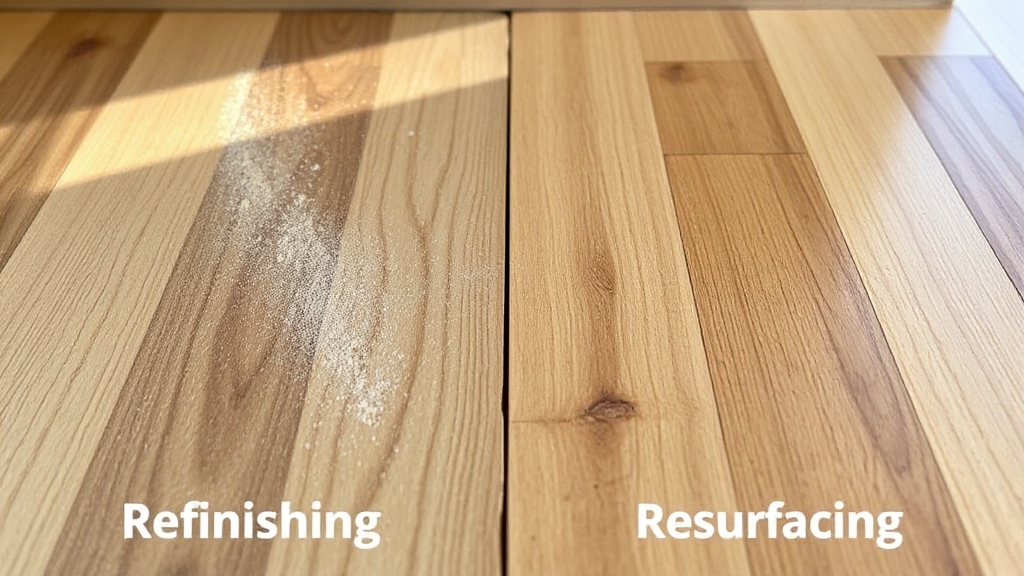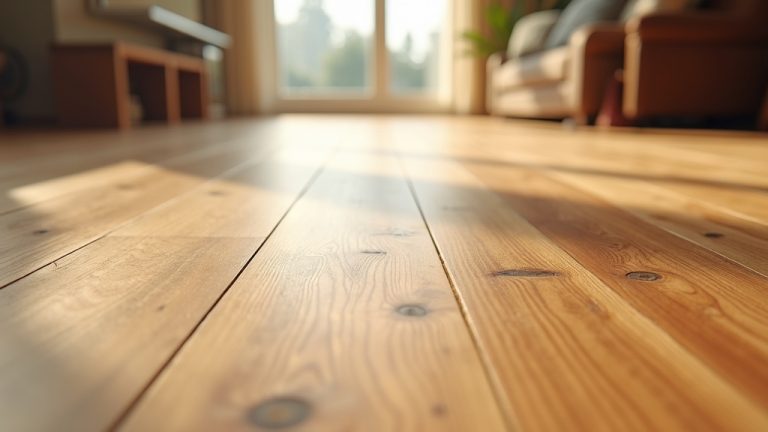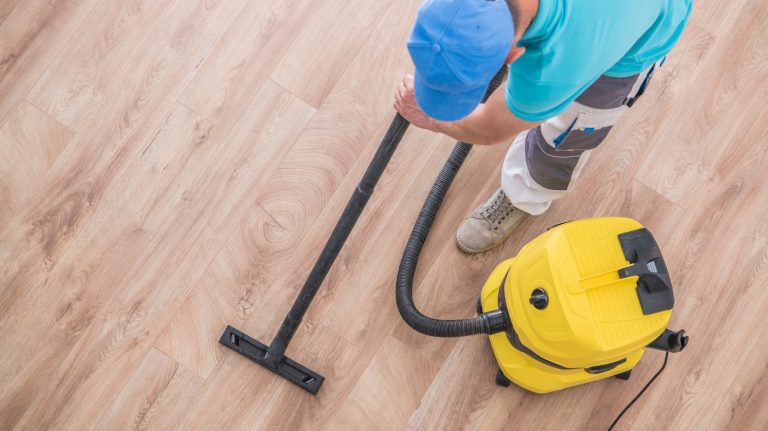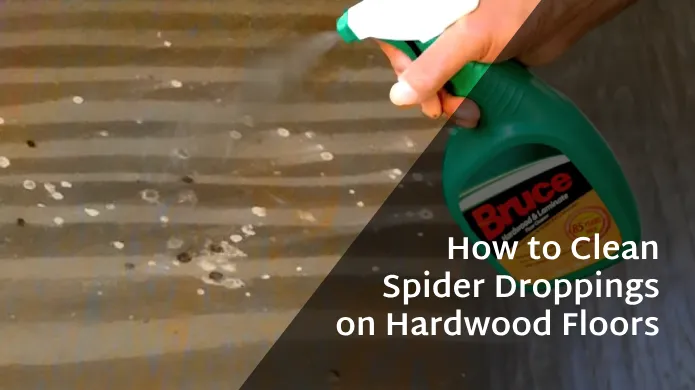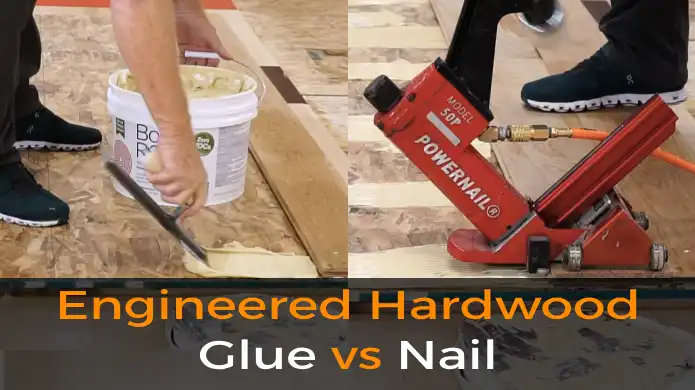Hardwood Floor Refinishing vs Resurfacing: Key Differences
When choosing between hardwood floor refinishing and resurfacing, you’ll want to contemplate damage depth and desired longevity.
Refinishing sands down about 1/32 inch, removing deep scratches and old finish, extending floor life considerably but requiring skilled labor and more time.
Resurfacing lightly buffs and recoats surface wear for a quicker, less invasive refresh with limited durability. Your floor’s condition, budget, and project timeline guide the best method, with further details below to help you decide confidently.
Key Takeaways
- Refinishing removes 1/32 inch or more of wood to eliminate deep scratches and restore durability, while resurfacing lightly buffs surface imperfections without sanding deeply.
- Refinishing requires skilled use of powerful sanders and takes 2-5 days, whereas resurfacing is quicker, less invasive, and more DIY-friendly.
- Severe damage or worn finish necessitates refinishing for long-lasting restoration; minor scuffs and surface wear can be addressed by resurfacing or recoating.
- Proper refinishing enhances home value and floor durability, while resurfacing provides a temporary visual upgrade suitable for stable, undamaged subfloors.
Hardwood Floor Refinishing vs Resurfacing Comparison Table
| Aspect | Hardwood Floor Refinishing | Hardwood Floor Resurfacing |
|---|---|---|
| Sanding Depth | Removes 1/32 inch of wood per cycle, exposing raw wood | Light buffing only, removes topmost finish layer (fractions of millimeter) |
| Damage Treatment | Eliminates deep scratches, dents, and discoloration by sanding to bare wood | Addresses only minor surface blemishes and cosmetic flaws |
| Equipment Required | Powerful drum and belt sanders, orbital sanders, edge sanders | Orbital sanders for light surface abrasion, chemical strippers |
| Skill Level | Requires skilled labor and expertise in wood grain management | More DIY-friendly, less technical expertise needed |
| Project Duration | 2-5 days including preparation and curing time | Quicker process, often completed within a day |
| Cost Range | $3-8 per square foot (80% labor costs) | Higher expenses due to repairs ($478-$1,624 for repairs alone) |
| Durability | High durability – can be refinished 4-12 times, significantly extends floor lifespan | Limited durability – temporary solution with shorter lifespan |
| Visual Impact | Restores original wood appearance, allows stain changes, high customization | Quick visual boost but limited customization options |
| Wood Thickness Impact | Gradually reduces floor thickness over multiple cycles | Preserves original thickness, allows more frequent maintenance |
| Best For | Floors with severe damage, deep scratches, water damage, worn finish | Floors with minor scuffs, surface wear, stable undamaged subfloors |
| Home Value Impact | Enhances home value significantly due to complete restoration | Temporary visual upgrade with minimal value increase |
| Frequency Possible | Limited cycles due to thickness reduction (typically 4-12 times) | More frequent maintenance possible without thickness impact |
| Structural Requirements | Requires minimum 3/32 inch wood above tongue for safety | Suitable for thinner wear layers without structural concerns |
| Dust Management | Requires extensive dust control and safety protocols | Minimal dust generation, less invasive process |
Refinishing and Resurfacing Processes
While both refinishing and resurfacing aim to restore hardwood floors, they involve distinct processes that affect their scope and outcome.
Refinishing begins with preparation—removing base moulding and readying the room—followed by sanding with progressively finer grits to smooth the surface.
You’ll fill gaps to guarantee uniformity, optionally stain the wood, and apply a protective finish to seal it. Before starting, it is important to seal air vents and doors to prevent dust spread during sanding.
Additionally, ensuring a seamless transition where hardwood meets tile or other flooring can enhance the overall appearance post-refinishing. Essential tools include floor and disc sanders, a shop vac, respirator, and tack cloth for dust removal.
Resurfacing, by contrast, often requires subfloor replacement and laying new material atop the existing floor after a thorough inspection identifies damaged areas. This method is more involved and costly but notably enhances durability.
Comparing the Depth of Sanding Between Methods
When you refinish hardwood floors, sanding removes about 1/32 inch of wood to expose raw surfaces and eliminate deep damage.
It is important to have a minimum of 3/32 inch thickness of wood above the tongue to ensure safe refinishing without compromising the floor’s stability.
Refinishing typically involves sanding, applying a new finish, and top coating to protect and enhance the wood’s appearance.
Resurfacing, on the other hand, uses lighter buffing techniques that only smooth surface imperfections without significant material removal.
Sanding Depth Differences
Because hardwood floor refinishing involves removing the finish and a layer of wood beneath, it requires substantially deeper sanding compared to resurfacing.
Refinishing typically sands down about 1/32 inch per cycle, exposing raw wood to eliminate deep scratches and damage.
However, you must guarantee at least 3/32 inch of wood remains above the tongue to prevent structural compromise. This process is generally suitable for addressing surface scratches and scuffs that do not affect the floor’s structural integrity. Proper sanding depth is crucial to maintain the floor’s durability and lifespan.
Over several refinishing cycles, you may remove up to 1/8 inch or more, gradually reducing floor thickness and lifespan. In contrast, resurfacing only removes the topmost finish layer, mere fractions of a millimeter, preserving the wood’s integrity.
It’s better suited for floors with thinner wear layers or minor surface blemishes, extending appearance without addressing deep damage, and maintaining overall floor thickness and longevity.
Equipment and Technique
Although both hardwood floor refinishing and resurfacing involve sanding, the equipment and techniques you use differ considerably due to the depth of material removed.
Refinishing demands powerful drum and belt sanders to remove old finishes and imperfections, requiring detailed sanding sequences and higher skill. Resurfacing uses orbital sanders for light, surface-level abrasion, focusing on quick finish removal with less training.
Edge and hand sanders assist in precision work for both. Choosing the right sander is crucial to prevent damage and ensure quality results, as the equipment choice depends on floor condition and project scope. Proper preparation and sectioning can also improve efficiency and quality in refinishing projects.
| Aspect | Refinishing | Resurfacing |
|---|---|---|
| Equipment | Drum, belt, edge, hand sanders | Orbital, edge, hand sanders |
| Sanding Depth | Deep | Surface level |
| Skill Level | High | Moderate |
| Process Duration | Days to weeks | Few hours |
| Noise Level | Loud | Moderate |
Surface Damage Removal
Since hardwood floor refinishing removes more material than resurfacing, it effectively eliminates deeper scratches, dents, and discoloration by sanding down to the raw wood, typically about 1/32 inch per pass.
This process targets both superficial and embedded damage, creating a clean, uniform surface ready for new finish adhesion. Additionally, the thickness affects longevity and refinishing potential of floors, making it crucial to consider how much material can be safely removed during the process. Removing soft underlay is also important to ensure proper floor stability and support during refinishing.
In contrast, resurfacing only buffs away the top finish and minor cosmetic flaws without sanding into the wood itself, preserving the original thickness. While resurfacing maintains shallow imperfections, refinishing removes them entirely, restoring the floor’s structural appearance.
Keep in mind, excessive refinishing reduces the wood’s thickness and limits future sanding cycles. Resurfacing allows more frequent maintenance since it doesn’t impact thickness but doesn’t address deeper damage like refinishing does.
Durability and Visual Impact of Each Technique
When you choose between hardwood floor refinishing and resurfacing, understanding their durability and visual impact is essential for making an informed decision.
Refinishing removes about 1/32 inch of wood, renewing the surface and enhancing durability by increasing resistance to scratches and wear. You can refinish hardwood floors multiple times, typically four to twelve, prolonging their lifespan considerably.
This process also takes advantage of the wood’s natural strength, especially when using hardwood species known for their sturdiness. Additionally, the thickness of the wood’s wear layer plays a crucial role in how many times refinishing can be performed, directly influencing the floor’s long-term durability.
Visually, refinishing restores the original wood appearance, allows stain or finish changes, and smooths surfaces, offering high customization and potential home value increase.
In contrast, resurfacing mainly applies a new layer, providing a quick, cost-effective visual boost but with limited customization and shorter durability. It often serves as a temporary solution that doesn’t fully restore hardwood’s natural beauty or longevity compared to refinishing.
Tools and Skill Requirements for Refinishing Vs Resurfacing
Understanding the durability and visual impact of hardwood floor refinishing and resurfacing naturally leads to contemplating the tools and skills each method demands.
Refinishing requires powerful sanding equipment like drum, orbital, and edger sanders, plus expertise in managing wood grain, dust control, and applying finishes. Proper dust collection system use is essential to maintain efficiency and protect health during refinishing.
Additionally, refinishing demands extensive knowledge of surface preparation to ensure proper adhesion of new finishes.
Resurfacing relies more on chemical strippers, scrapers, and applicator tools, alongside skills in chemical handling and precise timing for finish application. This method often involves chemical stripping techniques to remove old finishes without sanding.
Key distinctions include:
- Mastery of multiple sanding machines versus proficiency with chemical strippers and surface preparation
- Extensive dust management and safety protocols in refinishing compared to chemical safety in resurfacing
- Detailed knowledge of wood grain and sanding techniques in refinishing, while resurfacing focuses on repair and finish application skills
Cost and Time Investment Considerations
You’ll find that refinishing typically costs between $3 and $8 per square foot. Proper preparation and sanding are essential to achieve a smooth surface suitable for staining and finishing, which can affect overall costs.
Resurfacing often involves higher expenses due to necessary repairs. It may also require replacement of subflooring, which adds to the overall cost.
Project duration also varies, with refinishing usually taking 2 to 5 days. The time needed depends on factors like the type of hardwood and the extent of surface preparation, including sanding process. Resurfacing extends to 5 to 7 days or more.
Budget Comparison
Several key factors influence the budget for hardwood floor refinishing and resurfacing, including material costs, labor intensity, and the extent of damage requiring repair.
Refinishing generally costs between $3 to $8 per square foot, with labor making up roughly 80% of the total. This process typically includes sanding, staining, and finishing, which together restore the floor’s original shine and durability cost breakdown.
Regular maintenance and protection, such as using waterproof sealants, can help extend the life of the refinished floor.
Resurfacing tends to be pricier due to added repair and replacement expenses, ranging from $478 to $1,624 for just repairs.
When budgeting, consider these critical points:
- Square footage and wood type impact both material and labor costs.
- Significant damage increases resurfacing expenses due to necessary repairs.
- Refinishing offers cost-effective longevity, potentially reducing long-term maintenance.
Project Duration
Budget concerns often lead homeowners to weigh not just costs but also the time involved in hardwood floor projects. Refinishing demands more time due to extensive sanding, multiple finish coats, and longer drying periods.
Resurfacing, being less labor-intensive, can often be completed within a day with minimal disruption. Proper installation and humidity control can affect the overall project duration and floor longevity.
Your choice impacts scheduling, labor hours, and potential living arrangements. Additionally, refinishing is a more permanent solution suitable for floors with damage or deep scratches, while resurfacing is ideal for floors in good condition needing only surface renewal.
| Aspect | Refinishing | Resurfacing |
|---|---|---|
| Time Required | Several days/weeks | Under one day |
| Complexity | High (specialized) | Low (DIY-friendly) |
| Work Disruption | Significant | Minimal |
| Drying Time | Longer | Shorter |
| Labor Hours | Extensive | Limited |
Suitability for DIY Projects Vs Professional Services
Although both hardwood floor refinishing and resurfacing can be approached as DIY projects, the suitability largely depends on the scope of work, required skill level, and available equipment.
Resurfacing suits DIYers better since it demands less expertise, uses simpler buffing machines, and finishes faster.
Refinishing, however, requires advanced sanding equipment and experience to avoid uneven results. This is because refinishing restores the raw wood, allowing for repairs of scratches and dents.
Consider these factors before deciding:
- Time and effort: resurfacing is less intensive and faster for DIY.
- Skill and equipment: refinishing needs professional-grade tools and expertise.
If you prioritize durability and flawless appearance, professional services are advisable despite higher costs. For minor cosmetic fixes within budget and skill limits, DIY resurfacing is a practical option.
Selecting the Right Method Based on Floor Condition
When choosing between refinishing and resurfacing, you should first evaluate the condition of your floor’s surface and structure. If the damage is superficial, light scratches, minor discoloration, or surface wear, and the finish remains intact, resurfacing is suitable.
Resurfacing involves light sanding of the top layer to remove scratches and imperfections, making it a less invasive option.
However, deep scratches, gouges, dents, or water damage require refinishing, which involves sanding to bare wood and removing old stains.
Deep scratches, gouges, dents, or water damage call for refinishing to restore wood by sanding to bare surface.
Next, assess wood thickness; thick solid hardwoods tolerate multiple refinishes, while thin or engineered floors benefit from resurfacing to preserve material.
Also, inspect structural integrity: loose, squeaky, or cracked boards need refinishing for repairs, whereas stable floors suit resurfacing.
Consider previous finish types and wear; incompatible or degraded layers demand refinishing for uniformity and durability, especially in high-traffic areas. Your choice hinges on balancing surface damage, wood thickness, and structural soundness.
Balancing Budget, Time and Desired Results
Since hardwood floor maintenance involves multiple variables, you’ll need to carefully balance your budget, time constraints, and desired results to choose the best approach.
Refinishing typically costs $3 to $8 per square foot, influenced heavily by labor, and can take several days including preparation and curing. It also extends the lifespan of floors by sealing against water, scuffs, and scratches. Resurfacing tends to be more expensive due to repairs and material replacement.
Consider the following:
- Budget: Refinishing offers a cost-effective option compared to full replacement, with recoating as a cheaper alternative.
- Time: Traditional sanding is faster but dustier; dustless methods cost more but minimize health risks and cleanup.
- Desired Results: Refinishing enhances durability, aesthetics, and property value while allowing various finish options for long-term floor protection.
Frequently Asked Questions
Can Refinishing or Resurfacing Improve Floor Acoustics?
You can improve floor acoustics by choosing the right finishing process. Refinishing allows you to select finishes like European Oil that enhance sound absorption and reduce reflections, improving overall sound quality.
Resurfacing also helps by applying suitable finishes quickly and cost-effectively, though it doesn’t address structural sound transmission.
How Do Humidity Levels Affect Refinished Hardwood Floors?
You need to refinish hardwood floors within 35%-55% humidity to avoid issues. High humidity slows drying, causing uneven finishes and trapped moisture. Low humidity makes wood brittle, risking cracks during sanding.
Wood expands in humid conditions and contracts when dry, leading to cupping, gapping, or buckling. Controlling climate and allowing proper drying time guarantees a durable, uniform finish and maintains the floor’s structural integrity.
Are There Eco-Friendly Finishes Used in Refinishing or Resurfacing?
Like a fresh breeze through a forest, eco-friendly finishes refresh your floors safely. You can choose natural oils, water-based polyurethanes, or whey-based finishes like PolyWhey® Eco-Pro. These options emit low VOCs, meet strict standards like Greenguard certification, and reduce indoor air pollution.
They offer durable protection with less environmental impact, making them ideal for health-conscious homes and sensitive environments during refinishing or resurfacing projects.
Can Pets Damage Refinished or Resurfaced Hardwood Floors Differently?
Yes, pets can damage refinished and resurfaced hardwood floors differently. Refinished floors may still get scratched or stained, but a durable finish offers some protection if you maintain it well.
Resurfaced floors have enhanced structural integrity, making them less prone to deep damage, yet they’re not immune to surface scratches or stains. In both cases, prompt cleaning and pet behavior management are essential to minimize damage effectively.
How Soon Can Furniture Be Moved Back After Refinishing or Resurfacing?
Imagine freshly painted walls, you wouldn’t rush furniture back and risk damage. After refinishing, wait 24–48 hours before moving furniture, ideally 72 hours for full cure, especially with oil-based finishes.
Resurfacing usually requires at least 24 hours, but drying times vary by chemicals used. Temperature and humidity also affect curing.
Choose the Right Method for Lasting Floors
When deciding between hardwood floor refinishing and resurfacing, consider that refinishing removes up to 3/32 inch of wood, restoring floors down to bare wood, while resurfacing only lightly sands the surface.
Remarkably, refinishing can extend your floor’s lifespan by up to 20 years, making it ideal for worn floors. Balancing cost, time, and floor condition ensures you choose the method that delivers the durability and appearance you need without unnecessary expense or effort.

